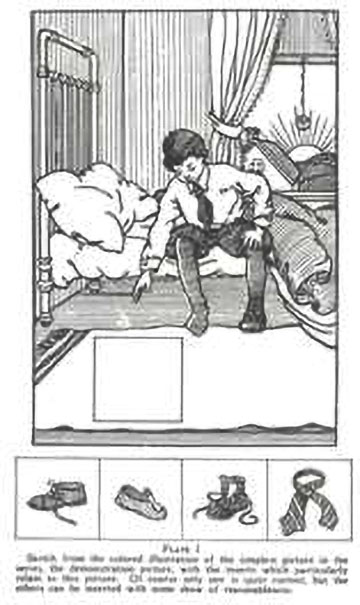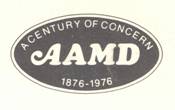1950s and 1960s: The Medical Model Prevails
A New Perspective Develops
Going into the second half of the 20th Century, the prevailing definitions of mental retardation and perspectives of service focused almost exclusively on deficits in the individual. Those definitions combined issues about general intelligence and the individual's ability to cope with the demands of everyday life. At the same time, a concept (the principle of normalization) was developing in Scandinavia. It would have a profound impact on definitions and perspectives in North America
The Medical Model and an Emphasis on Deficiency
Edgar Doll's 1941 definition set the standard for many of the more medical definitions of the century. Doll identified six criteria generally considered essential to an adequate definition and concept of mental retardation:
- social incompetence
- due to mental subnormality;
- which has been developmentally arrested;
- which obtains (remains) at maturity;
- is of constitutional [physical] origin; and
- is essentially incurable.

Edgar Doll
Levels of Disability
This basic definition soon evolved into determinations of the levels of disability. Most are linked to the measurement of I.Q. or Intelligence Quotient. "Subnormality" meant below the normal I.Q. of 100. Over the years, there have been important changes in how far below normal someone's I.Q. score had to be before being considered "mentally retarded".
The challenge for Goddard earlier in the century was to make sure people understood the difference between "feebleminded" and "moron." The challenge for most of the second half of the century was to expand the categories and attempt predictions on what individuals' lives would be like.
In the 1950s, the education system adopted a classification system based on ability to learn (Kirk, Karnes, & Kirk, 1955).
- "Educable" children could learn simple academic skills but not progress above fourth grade level.
- "Trainable" children could learn to care for their daily needs but very few academic skills.
- "Custodial" children were considered untrainable and therefore in need of long term care.
The terms "trainable" and "educable" are still in use today. By 1971, the President's Committee on Mental Retardation indicated that "educable" children could achieve sixth grade level academic skills, instead of only fourth grade, by their late teens.

Henry Goddard
AAMD Definitions
In 1959, the American Association on Mental Retardation (then called the American Association on Mental Deficiency) adopted this definition of mental retardation:
Mental retardation refers to sub-average general intellectual functioning which originates during the developmental period and is associated with impairment in adaptive behavior." (Heber, 1959, cited in J.D. Smith 381)
The AAMD Manual on Terminology and Classification in 1959 "suggested a three-level division of those with an IQ below 50 into moderately, severely, and profoundly retarded. This classification replaced a similar hierarchy from 1910 based on the "mental age" of the individual – idiots, imbeciles, and morons.
In 1961, the AAMD was more specific about what it meant by "sub-average". Anyone scoring below 85 on an IQ test would be considered sub-average. This created a very large category of people defined as "borderline". The generic terms of borderline (IQ 67-83), mild (IQ 50-66), moderate (IQ 3-49), severe (16-32), and profound (IQ <16) were adopted.
This meant that a great number of people could be considered "sub-average". In the general population, this might mean 16% of the people. It would be even higher in population groups where other factors lower intelligence test scores (though not necessarily intelligence) – minority status, language, or socioeconomic status.
The developmental period began at birth and ended at 16 years. In 1973, the end of the developmental period would change from 16 to 18 years. In 1983, the beginning developmental period would change from birth to conception.
In 1962, the President's Panel on Mental Retardation chose to use the four level classification and did not speak of "borderline". It adjusted the IQ scores associated with the four levels – mild (IQ usually 50 to 70), moderate (IQ usually 35 to 50), severe (IQ from about 20 to 35) and profound (IQ usually below 20). Interestingly enough, the 1971 report of the President's Committee on Mental Retardation used the five level AAMD scheme again.

Early IQ Testing

The President's Panel's Description
The President's Panel also described "mental retardation" as "a major national health, social, and economic problem". It emphasized the negative consequences to individuals, families and society.
- It afflicts twice as many individuals as blindness, polio, cerebral palsy, and rheumatic heart disease, combined.
- About 400,000 of the persons affected are so retarded that they require constant care or supervision, or are severely limited in their ability to care for themselves and to engage in productive work; the remaining 5 million are individuals with mild disabilities.
- Over 200,000 adults and children, largely from the severe and profound mentally retarded groups, are cared for in residential institutions, mostly at public expense.
- The Nation is denied several billion dollars of economic output because of the underachievement, underproduction, and/or the complete incapability of the mentally retarded.
- The untold human anguish and loss of happiness and well-being which result from mental retardation blight the future of millions of families in the United States.

1910 Model "Mental Age"
The President's Panel marked the beginning of major changes in how services were thought of and delivered in the United States. It also cemented a number of perceptions that took decades to overcome. In fact, no one actually required institutionalization. In fact, people could be supported to work. In fact, families could be happy.


From Closing the Gaps, 1966

